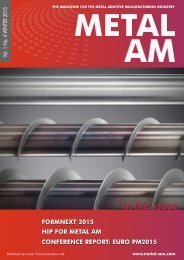AUTUMN
1SflouO
1SflouO
Create successful ePaper yourself
Turn your PDF publications into a flip-book with our unique Google optimized e-Paper software.
30.0<br />
89.7<br />
22.0<br />
Metal AM part development<br />
| contents page | news | events | advertisers’ index | contact |<br />
30.00<br />
36.9<br />
R3.5<br />
30.000<br />
69.4<br />
34.900<br />
25.0<br />
The part’s wall thicknesses fall<br />
between 1 mm and 1.75 mm, roughly<br />
.039”-.068”, and it’s critical that these<br />
walls do not vary much in thickness;<br />
if they end up just .010” thinner, the<br />
part could be unusable (Fig. 2).<br />
Harder yet, the inner diameters<br />
of both of the cylinders must be<br />
accurate and consistent. Again, variations<br />
of just .005” can have a big effect<br />
here - and if the cylinders end up with<br />
oval cross-sections, the part won’t<br />
work at all. Also, the titanium 6/4 that<br />
my part will be made of is notoriously<br />
prone to built-in stresses, meaning<br />
that we’ll have to be very careful<br />
setting up the build parameters and<br />
support structures to prevent the part<br />
from turning into a pretzel during the<br />
process.<br />
UNSPECIFIED DIMENSIONS IN mm<br />
STANDARD TOLERANCES:<br />
angular = + - 2<br />
x.xx = + - .3mm<br />
x.xxx = + - .13mm<br />
x.xxxx = + - .013mm<br />
BREAK ALL SHARP EDGES<br />
remained something of a fixture in<br />
my life. So when I started researching<br />
this new class of processes - ones<br />
which essentially amount to welding<br />
parts together from titanium powder<br />
- my mind went to the application<br />
that I knew well - bicycles.<br />
As potential markets for metal AM<br />
go, high end road cycling is an excellent<br />
candidate. Reductions in weight<br />
and wind resistance are incredibly<br />
valuable. Custom, bespoke designs<br />
are prized. Sales cycles are relatively<br />
short, making just-in-time production<br />
attractive. Customers of high end<br />
bikes tend to have buying habits that<br />
are price inelastic; an expensive new<br />
product that offers genuine benefits<br />
can survive regardless of its price<br />
tag.<br />
MATERIAL: Titanium<br />
FINISH: None<br />
designed and drawn by SPENCER WRIGHT<br />
info, documentation & jokes at pencerw.com<br />
copy my designs if you must, but do let me know first :)<br />
BK1033 Production Topper One.ipt<br />
Fig. 2 An initial drawing of the seatmast topper (Courtesy Spencer Wright)<br />
The seatmast topper<br />
The part I’m building is a seatmast<br />
topper for high end road bicycles<br />
(Fig. 1). At about 60 g, it’s fairly lightweight.<br />
It’s also relatively small and<br />
fits easily within nearly every DMLS<br />
machine’s build platform. Because<br />
of its function (seatmast toppers are<br />
used to hold a bicycle saddle onto the<br />
“As potential markets for metal AM go,<br />
high end road cycling is an excellent<br />
candidate. Reductions in weight<br />
and wind resistance are incredibly<br />
valuable”<br />
frame) its structural requirements are<br />
fairly predictable. These factors, plus<br />
the fact that seatmast toppers are<br />
easy for almost any cyclist to install<br />
on their own bike, make it a good<br />
candidate for AM.<br />
But that doesn’t mean it’s easy<br />
to print. The part consists of two<br />
cylinders, oriented 90° apart and<br />
joined together by a funnelled neck.<br />
2015.02.21<br />
SHEET<br />
5 of 5<br />
First stage prototypes with<br />
the help of DRT Medical<br />
Morris<br />
About a year before I began<br />
researching metal AM, GE acquired<br />
Morris Technologies, touching off a<br />
shift in the structure of the industry. I<br />
was aware of the acquisition because<br />
of GE’s PR push around open innovation,<br />
so when word came to me that a<br />
small group had spun out and formed<br />
DRT Medical-Morris, I was excited<br />
to talk to them. After a half hour on<br />
the phone with Dustin Lindley, I knew<br />
I had found a team that would be<br />
capable - and willing - to go through<br />
the initial prototyping phase with me<br />
hand in hand.<br />
I worked with Dustin (now at<br />
UCRI-University of Cincinnati<br />
Research Institute) and Dave Bartosik<br />
(his successor at DRT) through six<br />
build iterations of my part (Fig. 3). In<br />
all of them, the part was oriented on<br />
its side in an attempt to reduce total<br />
powder recoating time.<br />
With each iteration, we (and by<br />
‘we’ I mean Dave, whose creativity<br />
and enthusiasm for getting the build<br />
to work was inspiring) added solid<br />
supports in a number of places,<br />
chasing built-in stresses around<br />
the part with each iteration. The<br />
last of these prototypes, although<br />
non-functional, was nevertheless<br />
a big improvement on the earlier<br />
42 Metal Additive Manufacturing | Autumn/Fall 2015<br />
© 2015 Inovar Communications Ltd Vol. 1 No. 3



